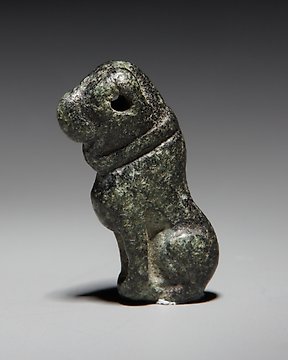
Antiguo Egipto Piedra Amuleto con forma de cánido. Período Tardío, 664 - 332 a.C. 1,8 cm de largo.
N.º 83275905

N.º 83275905

Heart Scarab
Ancient Egypt, Late Period 664 - 323 BC.
Stone.
4 cm H.
Condition: Good condition.
Provenance: Private collection Dr. W.G., Munich, 1960.
The heart scarab is an oval, scarab artifact dating from ancient Egypt. Mostly an amulet, it was also used as jewelry, a memorializing artifact, or a grave good. The heart scarab was used by referring to Chapter 30 from the Book of the Dead and the weighing of the heart, being balanced by Maat, goddess of truth, justice, order, wisdom, and cosmic balance. The function of the heart scarab was to bind the heart to silence while it was being weighed in the underworld to ensure that the heart did not bear false witness against the deceased. As in many current religions, the individual had to show 'worthiness' to achieve the afterlife. The heart was extremely important to ancient Egyptians as the seat of intelligence and the storehouse of memory. It was the only organ left in place during mummification. Heart scarab amulets were meant as substitutes for the heart should the deceased be deprived of the organ in the afterlife. For example, when a person died, a heart scarab was often placed on their heart and bound underneath the bandages of the mummy. This was to ensure that it could not be physically removed from their person.
The significance of the heart scarab to the ancient Egyptians also stems from the religious importance of the scarab beetle, Scarabaeus sacer. The scarab beetle represented rebirth and creation. As the beetle larvae grow, they eat their way out of the balls of dung where they were laid and emerge. The Egyptians saw this as the beetles emerging from nothingness into new life, which aligns with their beliefs in an afterlife and rebirth.
The amulets are described in the Book of the Dead to be made (per Andrews, Amulets of Ancient Egypt) of a stone: nmhf, nemehef (not now identified); typically green stones, green jasper, serpentine, and basalt. Andrews continues to say they are in fact made from: green or dark-green materials, such as glazed steatite, schist, feldspar, hematite and obsidian; also blue-glazed composition (faience), Egyptian blue, rock crystal, alabaster or red jasper. Instead of the head of a scarab, heart scarabs had the head of a human and were often inscribed with chapter 30B of the Book of Going Forth by Day. Heart scarabs were also used in the design of pectorals, which were a rectangular chest ornament.
The alternate heart amulet itself represents similar ideas, but is made in the form of the heart as used by the Egyptian language hieroglyph.
Notes:
- The piece includes authenticity certificate.
- The piece includes Spanish Export License (Passport for European Union) - If the piece is destined outside the European Union a substitution of the export permit should be requested, can take between 1-2 weeks maximum.
- The seller guarantees that he acquired this piece according to all national and international laws related to the ownership of cultural property. Provenance statement seen by Catawiki.
THE MINISTRY OF CULTURE FROM SPAIN ASKS ALL SELLERS FOR INVOICES OR OTHER DOCUMENTATION ABLE TO PROVE THE LEGALITY OF EACH ITEM BEFORE PROVIDING AN IMPORT OR EXPORT LICENSE.
#alienscollection
Cómo comprar en Catawiki
1. Descubre algo especial
2. Haz la puja más alta
3. Paga de manera segura